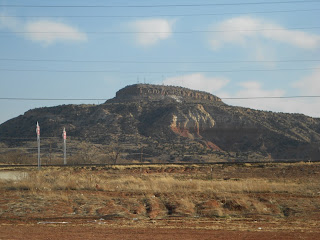 |
| Tucumcari Tonite Banner along Route 66 |
Tucumcari Along Route 66
The signs dotted historic Route 66 almost from it's inception. As you may remember, ther was also a Rout 66 song. When traveling west out of Texas, not only does the scenery change but vacationers will find Tucumcari, the first larger town they'll find in New Mexico. Many people consider it the gateway town to New Mexico.
At it's peak, Tucumcari offered travelers some 2,000 hotel rooms. Today, the number is a fraction of that amount. There is however a Tucumcari motel that has survived over all of those decades and that is the Blue Swallow Motel. Originally called the Blue Swallow Court, the Tucumcari NM hotel was built between 1930-1941 and it's believed to have opened for business in 1941.
The Colorful History of Tucumcari NM
Tucumcari has a long history of being a travel stop and a crossroads of sorts. In fact, the map of Route 66 changed over the years with various rerouting in some states including New Mexico, but as far as Tucumcari was concerned, the road always went through the center of town.
Before the automobile descended upon it, Tucumcari was a railroad town. Tucumcari was founded in 1901 even before Quay County itself was established. The year 1901 was also the time that the Chicago, Rock Island and Pacific Railroad built a construction camp in what is now the western portion of Quay County. The Rock Island camp was originally given the nickname of "Six Shooter Siding" because of it's too numerous gunfights.
Certainly not an inviting name and not a good name for a permanent community, the name of Tucumcari was adopted officially in 1908. This railroad was in competition with the Atchison Topeka & Santa Fe Railroad between Chicago and Los Angeles. The Rock Island route went through Tucumcari and then south to El Paso before heading west to California.
The AT&SF ran more to the north following much of the old Santa Fe Trail in New Mexico. The AT&SF Railroad along with Fred Harvey promoted Santa Fe heavily as a tourist destination. Although the railroad has always been a major part of Tucumcari, the town really gained it's biggest publicity from it's connection to old Route 66.
 |
| Tucumcari Mountain |
That's really a good question and there doesn't seem to be unanimous agreement among historians although their are a few credible answers.
What seems to be the best explanation comes from a man named Elliot Canonge, a linguist in Oklahoma. Canonge believes that the term is derived from the Comanche "Tukamukaru". This term means to lie in wait for someone or something to approach. Canonge also learned that Tucumcari Mountain was often used as a lookout. This does sound like a credible explanation.
Another historian has an equally convincing explanation. According to historian Herman Moncus, the name Tucumcari could have come from the Jemez Indians who hunted in the area of present day Tucumcari. Moncus says that he can translate Tucumcari into the Jemez language which means "place of the buffalo hunt".
Several Explanations for It's Name
Another explanation is less factual although quite colorful. The story that's floated around involves a story about an old Apache chief. The aged chief was very concerned as to who would take his place after he passed away. The answer the chief came up with was to select two candidates among the young men of his tribe and have them fight against each other with knives. The winner of the fight would assume the chief's role after he died. The two warriors were named Tonopah and Tocom. The chief also had a daughter named "Kari". The survivor of this fight would also win the chief's daughter for marriage. The tale goes on to say that Tocom, who Kari really loved, was slain by Tonopah. In her grief, Kari allegedly grabbed the kinfe, killed Tonopah and then killed herself. The distraught chief then killed himself and while dying cried out "Tocom-Kari", "Tocom-Kari". While not verified, the story still survives.
Visiting Tucumcari
 |
| A stretch of Route 66 through Tucumcari |
Tucumcari's business community points out their strategic location to major markets in Colorado, New Mexico and Texas.
Tucumcari also boasts Ute Lake Ranch which is a 25,000 acre master planned community on the north and south shores of Ute Lake. There is also a Ute Lake State Park. The lake area, a Canadian River reservoir, is home to ducks, quail, doves and pheasant. Deer and antelope can be found roaming about the surrounding plains and mesas. The park is located three miles west of Logan NM via N.M. 540.
Tucumcari as a Movie Set
When you drive to Tucumcari and view the scenery, you just have to know that the area was used as locations for various movie and television productions. For those who remember the old television western series "Rawhide", many of the scenes were shot around Tucumcari between 1959 and 1966. There was a movie produced in 1971, "Two-Lane Blacktop" which has a scene showing Tucumcari Mountain in the background. Another movie credit that Tucumcari can boast about involves the Sergio Leone 1965 production of "For a Few Dollars More". That movie starred both Clint Eastwood and Lee Van Cleef.
Another article on Western trips you'll find interesting is the story of historic Puerto de Luna New Mexico.
Tucumcari is a very interesting and scenic place to visit with a lot of old Route 66 nostalgia. When you're on that western road trip on Interstate 40 in eastern New Mexico you just might want to make it Tucumcari Tonite.
(Article and photos copyright Western Trips)

